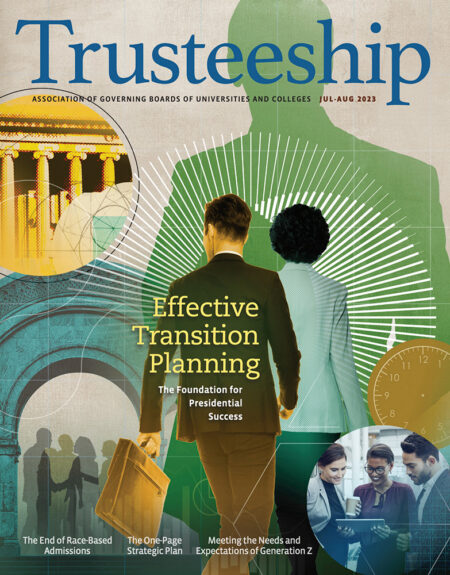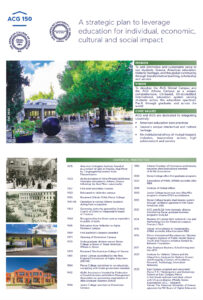
In Meeting the Challenge: America’s Independent Colleges and Universities Since 1956, historian John Thelin writes, “In place of piecemeal measures, by 1980 the presidents and other administrators at independent colleges were reading—and heeding—books about strategic planning and other approaches to management that encouraged rethinking how colleges work. The influential books included Lewis Mayhew’s Surviving the Eighties (1980) and George Keller’s Academic Strategy (1983).”
This comment caught my attention because Lewis Mayhew was my major professor in my doctoral program at the Stanford Graduate School of Education in the mid-to-late 1970s. As part of an assignment for a seminar he led, I developed a strategic planning model, which he subsequently included and recommended (with attribution) in Surviving the Eighties. Although I have adapted that early model considerably in my three presidencies (Barrington College, 1979-1985; North Park University, 1987–2004; the American University of Greece and the American College of Greece, 2008–present), strategic planning has been an essential tool in my approach to presidential leadership.
However, despite strategic planning’s ubiquity in U.S. higher education administration in the years since the publishing of Surviving the Eighties, strategic planning’s utility today is questioned by some higher education leaders. For example, in “The Truth About Strategic Plans,” (Chronicle of Higher Education, September 29, 2021), author Lee Gardner references Georgia Nugent, the current president of Illinois Wesleyan University and former president of Kenyon College, saying she’s, “never led a traditional strategic-planning process and has no intention of starting one anytime soon.… Happily, currently, my board chair feels the same way.”
I share at least some of President Nugent’s skepticism about traditional strategic planning processes. These processes typically require substantial investment of institutional time, energy, and, sometimes, finances. Yet too often they seem to yield narrative-heavy documents that feature elaborately word-smithed mission and vision statements and politically palatable preferences, but ultimately fail to align or drive organizational behavior or deliver the hoped for organizational impact.
A Non-Traditional Approach
Twenty-five years ago, while president of North Park University and on a long flight from Chicago to Alaska, I assigned to myself the challenge of re-formatting North Park’s strategic plan into one, large, four-column page. The experiment yielded a format that I have evolved significantly since, especially in my current presidency at the American University of Greece (AUG) and the American College of Greece (ACG), where the “One-Page” Strategic Plan (the 2022/23 version shown here) has become a core component of the administrative and board governance of the institutions.
“One-Page” Strategic Plan’s Features and Benefits
This more streamlined approach to strategic planning incorporates several familiar/traditional features, e.g.: mission, vision, core values statements; strengths, weaknesses, opportunities, threats (SWOT) analysis; strategic goals; strategies for achieving goals; and a key metrics dashboard. It also includes several non-traditional features, most notably a large single-page format with four columns; a focus on current year operational priorities; and a key metrics dashboard incorporating a ten-year retrospective (2012), current year (2022) and medium-term (2025) projections, and a long-term projected institutional profile (2035). Based on my experience, the benefits associated with these non-traditional features of the one-page plan are substantial. They include:
1. Sparse Narrative, Strategic Numbers. While not every salient target in a college or university strategic plan is quantifiable, numbers will usually confirm (or not) whether a plan is grounded in pragmatism. Too often, traditional strategic plans are long on words and short on critical numbers. My simplified format strives to keep the number of words limited and draw organizational attention to strategically relevant numbers.
2. Concise Communication, Multipurpose Application. Due to their size and complexity, traditional strategic plans are not easily communicated. My version, though, is a “quick read” that gives readers and audiences an accessible overview of the institution’s history, operating context, short-term and long-term objectives, strategies, and results. The format lends itself to multiple applications in various institutional contexts: reports to the board of trustees; annual reports; reports to accreditors; updates to the campus community; performance evaluations of administrators and staff; input into academic and administrative departmental operating plans. In these ways, the strategic plan becomes an integrating link across the entire institution.
3. Long-Term Vision, Short-Term Adaptability. According to “Gates’s Law” (based on a comment made by Microsoft founder, Bill Gates, but attributable to several other commentators as well): “Most people overestimate what they can achieve in a year and underestimate what they can be achieve in ten years.” Traditional strategic plans have a five-year time horizon, representing, in my view, a compromised middle ground—too long to anticipate changes in a dynamic operating environment and yet too short to capture an institution’s long-term strategic potential. By contrast, the approach I have fashioned includes both an explicit long-term perspective as well as provision for adaptability to changing circumstances in the short-term.
When introduced at the American College of Greece in 2008/09, the one-page plan included a distant dashboard target of 2025, the college’s 150th anniversary year. This long-range projection functioned as a kind of “North Star,” pointing us toward what we envisioned as the institution’s optimal future even during times of short-term operating challenges (e.g., the Greek financial crisis of 2009, which ultimately lasted nearly a decade). Most recently, as we approached 2025 (and as most of the 2025 targets were reached and/or exceeded), a new “North Star” target has been set for 2035.


At the conclusion of each academic year, I ask members of my cabinet to suggest changes to the strategic plan. These proposed changes may include revisions in any aspect of the plan, including in its mission, vision, and core values; SWOT analysis; the four major goals of the document; the strategies and annual priorities that support the goals; or the benchmark targets. I consider these suggestions as part of my revision of the plan over the summer months.
The revised plan is then introduced in the fall, typically to the campus community in an all-college meeting and to the board of trustees at the fall board meeting. Both the plan’s brevity and the annual revision process make maintaining and assuring the currency of the plan easier and more certain, because they do not require
convening a separate committee or other elaborate, time-consuming meeting arrangements.
4. Top-Down, Inclusive, Listening-Based Planning. As president, I assume responsibility for the annual (and occasionally more frequent) revisions of our strategic plan. In this sense, the planning process is “top-down”; in fact, the ACG/AUG Strategic Plan is often referred to by faculty and staff as “the president’s plan”—a label I have tried rather unsuccessfully to discourage. On the other hand, because the plan is communicated widely in various settings, there are ongoing opportunities for reaction and input from stakeholders. Indeed, the record of ideas and initiatives incorporated in the document over the years reveals that most of the ideas/initiatives have originated from other administrators, faculty, staff, students, board members, alumni, donors, etc. My role has been to assess the potential of their ideas and to flesh out ideas or initiatives often suggested by others and then to integrate them, along with some of my own, to form a coherent, comprehensive institutional strategy. In this way, I contend that the planning process is in some ways “top-down” but also inclusive and listening-based.
5. Collaborative Presidential and Board Engagement. Sometimes I employ the metaphor of “collaborative artist” to describe the role of an institutional president, an individual working with others to weave together the various institutional “materials” (human, financial, intellectual, physical) to create something meaningful, beautiful, enduring. The streamlined plan, through its accessibility and continuous evolution, lends itself to this sort of collaborative, creative presidential role.
A particularly important area of strategic collaboration—reflection and decision-making—depends, of course, on the interaction between the president and the board of trustees. Boards of colleges and universities in recent years have been encouraged to focus more of their time and attention on strategic institutional issues and less on operational updates and routine matters. Here too, my approach has proven to be a useful tool, both as a resource for board discussions of and decisions on institutional strategy, but also for connecting the board’s evaluation of institutional and presidential performance to the strategic document. For example, I organize my report for each of the three board meetings per year around the institution’s performance on the four major goals of the strategic plan. And my annual self-evaluation, which is the basis for the board’s annual evaluation of my performance is also organized around performance related to the same four goals.
6. A Focus on Implementation, Organizational Motivation, and Alignment. In speaking to both internal and external audiences about our strategic plan, I often stress that organizational performance is “20 percent strategy, 80 percent implementation” and that strategic plans are not self-fulfilling. They become powerful only as they are understood and embraced by the wider organization and as the plan is integrated into the operating plans and behaviors of departments and individuals aligned with and supportive of the overall institutional strategy. For this to occur, managers and individuals throughout the organization need to understand, be inspired by, and believe in the achievability of the plan. The one-page format, regular references to the plan in reports and meetings, and the documented progress towards ambitious, long-term institutional goals and objectives have contributed significantly to building the required understanding, inspiration, belief, and motivation that have guided and aligned organizational behavior at our institutions.
Strategic Planning Checklist
Based on my experience with both the potential and the limitations of strategic planning in higher education, the following questions should be considered by institutions wishing to optimize the return on their investment in a strategic planning process:
- Who is the “primary owner” of (the individual responsible for) the institutional strategic plan, and to what extent is the president invested in the planning process and product?
- Do the institution’s resources and operating context require a primary focus on short-term results or are there sufficient resources to pursue a longer-term vision that may include or even require short-term losses or sacrifices?
- Does the strategic plan contain a clear, coherent overall strategy outlining why the institution is special, for example in its academic program, attraction for segments of the student market, geographical focus, academic brand positioning, or a unique value proposition? Does it appropriately balance short-term operational priorities and longer-term aspirations?
- Does the plan include the key quantitative measures (rooted in sufficiently robust institutional data resources) that define institutional effectiveness in executing the institution’s mission?
- Is the plan broadly understood by internal and external constituents?
- Is the plan integrated with other institutional planning, managerial, and reporting functions?
- Is the plan reviewed and revised at least annually?
- Is the plan readily amendable in the event of unforeseen circumstances?
Conclusion
Every college or university needs a strategy. It may be more or less explicit, but the process for determining and adapting that strategy and translating it into effective implementation is an important administrative and governance consideration. The approach outlined here has been beneficial in my experience and may be helpful to other institutions that, as in the 1980s, are once again coping with a gauntlet of imposing challenges. These include competing visions of the purpose(s) of higher education; another pending U.S. “demographic cliff” (echoing the 24-percent drop in U.S. high school graduates between 1979 and the early 1990s); the continuing disruptions of the global pandemic and technological innovation; shifting expectations among the institution’s constituents; cultural tensions; political pressures; and resurgent inflation.
The core responsibility of a president is the comprehensive advancement of the institution. A strategic plan is the blueprint for that advancement. Given the president’s core responsibility and role in coordinating the functional areas of the institution and serving both internal and external constituencies, it is logical that the president provides leadership in the development and evolution of the institution’s strategic plan. The approach I have outlined can facilitate both the president’s leadership role and the participation of other stakeholders, including the board of trustees, in the planning process.
At my inauguration as president of North Park in 1987, Lewis Mayhew addressed the audience and me with these words: “I know, David, that you are devoted to the discipline of strategic planning. I would like to advise you, however, that the most significant developments in your tenure as president are almost certain to be the unplanned.”
Like so many other insights of my mentor his words have proven powerfully true in my experience as an institutional president in the more than 35 years since he proffered that advice. That said, the streamlined planning approach I have outlined strikes, for me, an appropriate balance between a measured investment in the thoughtful, organizational behavior that underlies strategic planning while allowing appropriate responses to the unpredictable but inevitable— sometimes unwelcome but not always—intrusion of the unplanned
David G. Horner, Ph.D., is president of the American University of Greece (AUG) and the American College of Greece (ACG), a U.S.-based and U.S.-accredited comprehensive educational system serving over 7,000 students from more than 70 countries.
RELATED RESOURCES

Reports and Statements
Collaborative Leadership for Higher Education Business Model Vitality



